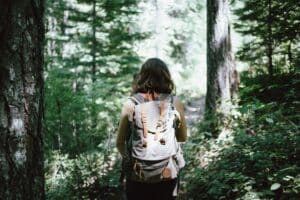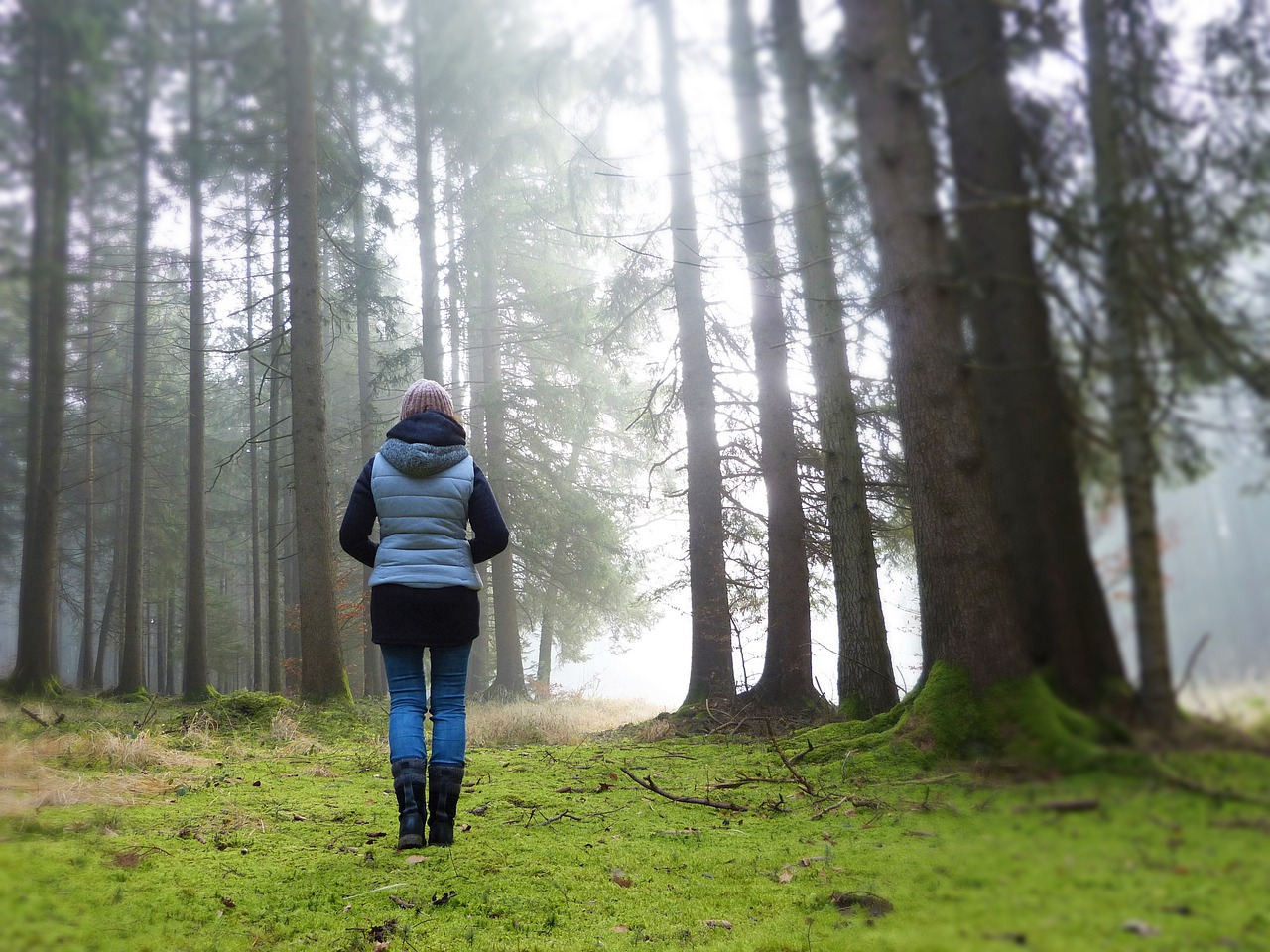A Guide to Forest Bathing
Are you feeling anxious, overwhelmed, stifled, or stressed? Have you ever wondered why experts universally suggest going outside to get some fresh air?
It turns out, this advice can be quite beneficial. The reason why going outside is so greatly appreciated stems from the reciprocal relationship between humanity and nature.
Going outside and making a nature connection, even for a few minutes, can result in cortisol, the stress hormone, being lowered almost instantaneously. Chances are good that you’ve experienced, on some level, the calm and relaxed state that being out in nature can provide, and forest bathing allows you to go even deeper.
What is Forest Bathing?
First, contrary to its name, forest bathing involves no actual bathing. Nor is it simply a hike in the woods from point A to point B. Forest bathing is an intentional reconnection between humanity and nature. It’s the slow process of spending meaningful and mindful time in the forest and receiving nature in its entirety.
Forest bathing is a practice, a slow art of tuning in and experiencing the environment by detaching from the “noise” of everyday life and tuning into nature with all your senses.
The experience of forest bathing is unique to each person. It is driven by tuning with the intention to give attention with all your senses to the present moment in nature. Each experience gives you the time needed to develop and deepen the relationship between you and the environment, promoting mindfulness and nature connection.
It’s a practice of nature awareness and appreciation; a recognition of how you and nature interact with each other and how nature interacts with itself.
The History of Forest Bathing
The term forest bathing is translated from the Japanese phrase shinrin-yoku. The concept of forest bathing was developed in the 1980s by Japan’s Ministry of Agriculture, Forestry and Fisheries (MAFF). And, in 1982, Japan made forest bathing a form of mobile meditation in its national health program.
Forest bathing is an age-old practice, though its name is fairly new. Many cultures have long understood and recognized the importance of the natural world to human health.
Tomohide Akiyama, the Director General of MAFF, is credited with developing the concept of forest bathing as a response to Japan’s tech-boom burnout culture.
Akiyama noticed not only the ill effects of Japan’s widespread nature deprivation, but also the need to preserve and protect Japan’s diminishing forests.
His aim for this form of ecotherapy was to serve as a lesson in reciprocity. He hoped that the more time Japan’s residents spent in and with nature and receiving its healing benefits, they would be inspired to preserve and protect it.
Japan has since created 10 forest medicine bases nationwide, each with its own on-site medical professionals to assist prior to and following your forest bathing. Additionally, Japan now has 62 certified therapy forests, each ranked based on their available healing elements.
Health and Other Benefits of Forest Bathing
Communing with nature grants many health benefits, including:
- A reduction in depression and stress
- An increase in attention
- A boost in immune function
- An improvement in cardiovascular and respiratory health
- A reduction in blood pressure
Additionally, forest bathing restores our relationship with the natural world, promoting reciprocal appreciation of nature’s presence within the world and humanity’s presence within nature.
How to Prepare for and Go Forest Bathing
Picking the right location
What’s most important when picking a place to forest bathe is to find a comfortable environment.
While it is called forest bathing, a more accurate name might be nature bathing, as you do not have to be in a forest environment or remote “serene” location completely off the grid. It could be your backyard, a trail, a local park, a botanical garden, a national park, or any location in nature.
Remember the focus is on mindfulness not exercise, so often a two-hour forest bathing session will cover less than a mile in length. Consider researching off-peak hours to enhance the likelihood of minimal traffic for bathing.
If you’re in Minnesota’s Twin Cities, a few of my favorite forest bathing locations are:
- Theodore Wirth Regional Park,
- Crosby Farm Regional Park,
- Fish Lake Regional Park,
- Caponi Art Park,
- University of Minnesota Landscape Arboretum,
- Elm Creek Park Reserve; and
- Lake Elmo Park Reserve.
Choose Guided Forest Bathing or Solo Forest Bathing
Choosing to forest bathe guided or solo depends on you.
Guided forest bathing with trained and experienced facilitators is a great experience for practitioners of all levels, but especially for those new to forest bathing.
Solo forest bathing sessions can help cultivate a strong self-wandering practice, a core routine of nature connection, and can help encourage introspection through solidarity.
How Long Should You Forest Bathe?
While forest bathing sessions can be indefinite, it has been shown that 120 minutes (two hours) a week is the optimal amount of time to reap the ultimate amount of its health benefits. And, consider trying to increase these health benefits by exercising outside too.
Don’t let this amount of time intimidate you, remember this is your forest therapy practice and you make the rules. Forest bathing isn’t a chore, it’s an experience and lifelong practice.
Whether you have 10 minutes per day or 30 minutes 3 times a week, that’s great. The important part is that you get out there and start. Your practice should grow and flow like the forest.

Some Forest Bathing Best Practices
- Take a moment to slow down and settle both your body and mind before going.
- Turning off your phone to decrease distractions.
- Taking some deep, long breaths to tune in to your senses and emotions and to tune out thoughts and issues of daily life.
- While walking, focus on each step’s interaction with nature. Consider changing your pace to see how it affects your experience.
- Look for opportunities to reconnect with joy and awe. Consider changing your perspective, such as closing your eyes for a short time, sitting down, taking off your shoes and socks, or laying on the ground looking up at the sky.
- Safety Tip: Before heading out, always dress yourself in appropriate gear and if you’re not bringing a friend, make sure to let someone know where you’ll be and for how long.
- Once you’ve arrived, make sure to always be aware of your surroundings and to stay close to marked paths and trails.
- Depending on when and where you’re going, don’t forget to consider the potential for allergies, insects like ticks and mosquitos, and the need for sun protection.
Interested? Here’s how to start forest bathing.
Forest bathing is a practice of nature connection and nature mindfulness, an artform of reciprocity, introspection, relaxation, and detachment.
If you’d like to learn more about forest bathing and your local environment click here to visit my bookshop site to browse through my list of suggested nature-inspired books.
Search your soul, wander in nature, breathe, and experience.
Join me for a group walk or book a private session to take the first step towards improving your mental and physical health through forest bathing!
Do you have a furry friend you’d like to include on your next forest bathing experience? Click here to learn how to forest bathe with your dog.
*When you buy through links on my site, I may earn an affiliate commission at no additional cost to you. This keeps it 100% reader supported and free of ads or sponsorships. Thanks for your support!

